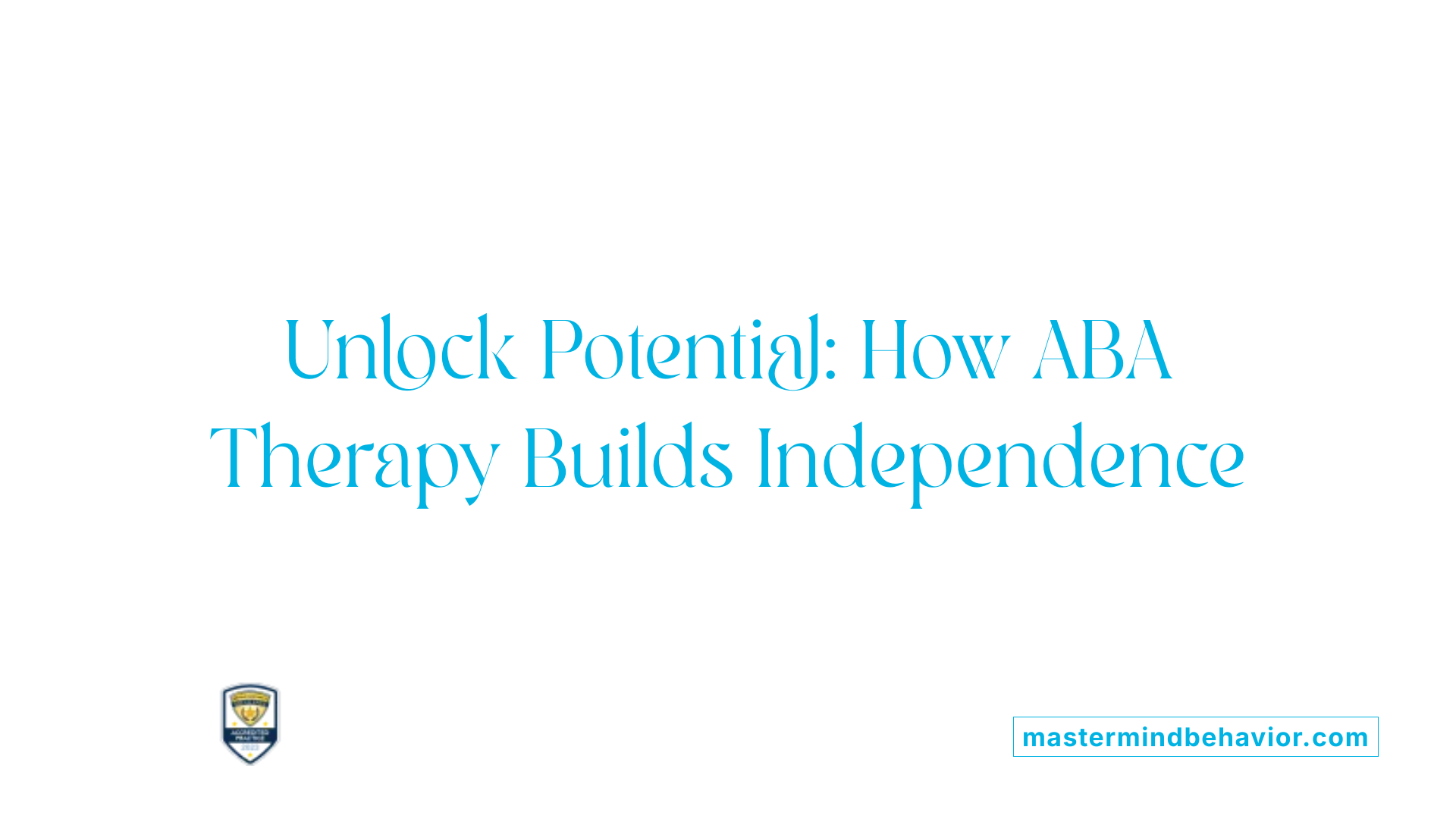ABA Therapy To Reduce Over-Reliance On Adults For Problem Solving

Understanding ABA Therapy and Its Role in Autism Support
Applied Behavior Analysis (ABA) therapy represents a scientifically validated approach designed to cultivate essential skills and reduce dependency on adults for problem-solving, especially in individuals with autism spectrum disorder (ASD). This comprehensive therapy, grounded in behavioral science, is tailored to the unique needs of each learner to promote functional independence and enhanced quality of life through individualized programming and evidence-based interventions.
What is ABA Therapy and How Does It Foster Independence in Individuals with Autism?

What is Applied Behavior Analysis (ABA) therapy, and how is it used to support individuals with autism?
Applied Behavior Analysis (ABA) therapy is a scientifically grounded treatment that applies behavioral principles to help individuals with autism spectrum disorder (ASD) acquire essential skills. It targets an individual's unique needs, emphasizing personalized programming rather than a one-size-fits-all approach.
Definition and Use of Behavioral Principles
ABA therapy focuses on understanding and modifying environmental factors to encourage skill development and reduce challenging behaviors. Techniques like positive reinforcement are central; they reward desirable behaviors, increasing the likelihood of recurrence. By systematically assessing behavior antecedents and consequences, ABA practitioners tailor interventions that promote learning and behavioral change.
Individualized Programming
Each ABA program is customized to the learner’s strengths, challenges, and personal goals. This personalized framework ensures that therapy remains relevant and effective, including skills such as communication, emotional regulation, daily living activities, and social interaction.
Skill Acquisition and Problem-Solving Promotion
ABA therapy aims to teach socially significant and adaptive skills. Through structured sessions and naturalistic settings, learners develop functional communication, emotional control, play skills, and safety awareness. The learning process often involves breaking complex tasks into smaller steps using chaining and fading strategies, allowing gradual mastery and independence.
Key Techniques: Positive Reinforcement and Data-Driven Progress Monitoring
Fundamental to ABA is the consistent use of positive reinforcement, encouraging progress by rewarding achievements. Behavior analysts collect detailed data during sessions, enabling them to track improvements, adjust interventions, and ensure that goals are met effectively.
Modern Approaches: Naturalistic and Person-Centered Methods
Contemporary ABA emphasizes respectful, person-centered care that supports autonomy and diversity. Naturalistic teaching incorporates the learner's environment and interests, making skill generalization more effective. Modern practices focus on using least intrusive prompts and fading them systematically to foster independence without coercion or punishment.
Through these scientifically informed and compassionate strategies, ABA therapy works to empower individuals with autism, enhancing their communication, social skills, and independence for better quality of life and societal inclusion.
Key Components and Techniques in ABA Therapy That Support Problem-Solving Skills
Manipulating Environmental Variables
ABA therapy strategically alters the environment to encourage desired behaviors and skill acquisition. By adjusting stimuli and contexts, therapists create optimal learning situations that promote problem-solving and adaptability.
Positive Reinforcement
This technique rewards desired behaviors immediately after they occur, strengthening their future occurrence. Consistent positive reinforcement motivates individuals to engage in problem-solving and develop new skills.
Functional Behavior Assessment (FBA)
FBA identifies the reasons behind specific behaviors by analyzing antecedents and consequences. Understanding the function of a behavior allows for targeted interventions aimed at replacing problematic behaviors with effective problem-solving strategies.
Behavior Intervention Plans (BIPs)
Based on FBA insights, BIPs outline structured approaches to address behaviors. These plans include specific goals and tailored techniques to support the individual’s growth in problem-solving and adaptive functioning.
Prompt Fading and Chaining
Prompt fading involves gradually reducing assistance so individuals perform tasks independently, while chaining breaks complex tasks into small steps linked together. Together, these methods build independent problem-solving skills through scaffolded learning.
Naturalistic ABA Components
Naturalistic ABA leverages contextual clues like antecedent stimuli found in everyday settings. It uses the person’s interests as reinforcement, making learning relevant and promoting the generalization of problem-solving skills across environments.
Least to Most Intrusive Prompting
This approach begins with minimal assistance, increasing support only as needed. By systematically fading prompts, individuals gain independence and confidence in applying problem-solving techniques autonomously.
Together, these components and methods foster independence, enhance adaptive behaviors, and develop lifelong problem-solving abilities in learners using ABA therapy.
Early Intervention and Intensity: Maximizing Success and Independence Through ABA
Why is starting ABA therapy early important?
Early intervention, ideally beginning by age 3, is crucial in Applied Behavior Analysis (ABA) therapy. Research shows that initiating therapy at this young age supports better long-term development for children with Autism Spectrum Disorder (ASD) and other neurodevelopmental conditions. Early ABA capitalizes on critical developmental windows, promoting the acquisition of vital communication, social, and adaptive skills when the brain is most malleable.
What is the recommended intensity of ABA therapy?
Optimal outcomes are linked to a structured and intensive therapy schedule. Typically, ABA therapy entails 20-40 hours per week, delivered across several sessions. This dosage, continued for at least two years, provides sufficient repetition and practice for children to master essential skills and encourages the development of independence.
What long-term benefits does early ABA intervention provide?
Children receiving intensive early ABA therapy often demonstrate significant improvements in social interactions, emotional regulation, and daily routines. These gains support enhanced educational achievement and reduced dependence on additional therapies. Over time, early intervention decreases the likelihood of needing extensive adult problem-solving support related to behavioral or communication difficulties.
How does early ABA therapy impact life skills and daily routines?
ABA therapy systematically teaches socially significant and functional skills, including daily living activities such as self-care and communication. Early focus on these skills helps children establish routines and habits that form the foundation for independent living. The individualized nature of ABA ensures treatment plans address each child's unique needs and promote practical skill acquisition.
What is the connection between early therapy and reduced adult reliance on problem-solving?
Starting ABA early not only advances developmental milestones but also fosters lasting independence. Improved communication and behavioral regulation achieved through early therapy reduce challenges faced during adolescence and adulthood. Consequently, this decreases the reliance on caregivers and professionals, enabling individuals to navigate social, educational, and vocational settings with greater autonomy.
Qualifications and Certification: Ensuring High Standards in Autism-Focused Behavioral Therapies

What qualifications and certifications should professionals providing autism-focused behavioral therapies have?
Professionals delivering autism-focused behavioral therapies need to possess specific certifications and training to ensure they provide effective and ethical treatment. The foremost credential is the Board Certified Behavior Analyst (BCBA) certification. Becoming a BCBA typically involves earning a master's degree in behavioral sciences or related fields, completing between 1,500 to 2,000 hours of supervised practical experience, passing a rigorous certification exam, and maintaining certification through ongoing education.
The Registered Behavior Technician (RBT) credential represents a paraprofessional role under BCBA supervision. RBTs provide direct ABA therapy and assist in implementing treatment plans, requiring a high school diploma, completion of 40 hours of training, and passing a competency assessment.
In addition to BCBA and RBT certifications, professionals might pursue designations like the Certified Autism Specialist (CAS). This credential demands a master's degree, specialized autism-focused training, and commitment to continuing education. It signifies advanced expertise in autism spectrum disorder and related interventions.
Ongoing education and adherence to ethical standards are critical. The Behavior Analyst Certification Board (BACB) governs certification requirements and mandates professional development to ensure practitioners remain up to date with research and ethical practice guidelines. The BACB's updated ethical code emphasizes humane, respectful, and competent care.
Together, these qualifications attest to a provider’s capability in behavioral assessment, individualized intervention, collaboration with families and multidisciplinary teams, and commitment to evidence-based, ethical autism therapy.
The Role of Family and Environment in Enhancing Independence Through ABA

Family Education and Involvement
Family education is a cornerstone of effective ABA therapy, helping parents and caregivers understand behavioral principles and the specific needs of their loved ones. By involving families directly, ABA therapy empowers them to support skill development consistently across daily routines.
Collaborative Treatment Planning
ABA programs are tailored to individual learners through collaborative planning involving therapists, families, and sometimes educators. This partnership ensures goals align with the child’s unique strengths and challenges, making interventions more meaningful and effective.
Effects on Family Dynamics and Communication
Engagement in ABA therapy often leads to improved family communication and dynamics. Families gain insight into behavioral strategies and emotional regulation techniques, fostering a more supportive and understanding home environment.
Delivery Settings: Home, Clinics, Educational Institutions
ABA therapy’s flexibility in delivery settings—such as homes, clinics, or schools—allows for skill acquisition in natural and diverse environments. This variety supports more generalized learning and real-world application of skills.
Naturalistic ABA Promoting Skill Generalization in Everyday Contexts
Naturalistic ABA strategies use the child’s everyday environment as a teaching context. By leveraging natural cues and interests, this approach enhances generalization of learned behaviors, helping individuals apply skills across settings and situations.
Supporting Transition to Independence and Employment
ABA therapy extends beyond childhood to support adults with autism in developing life, social, communication, and vocational skills. This comprehensive approach facilitates smoother transitions to independence and employment, enhancing quality of life and societal inclusion.
Coverage of Skills and Behaviors: Building a Broad Skill Set for Problem-Solving
What Areas Does ABA Therapy Address?
ABA therapy targets a diverse range of skills essential for daily functioning and independence. It supports communication development, social interaction, academic abilities, daily living tasks, play skills, sensory integration, and safety awareness. This comprehensive approach ensures that individuals gain functional skills applicable across various life domains.
How Does ABA Help Reduce Challenging Behaviors?
A significant focus of ABA is to decrease difficult behaviors such as aggression and self-injury. Through functional behavior assessments and tailored intervention plans, ABA practitioners identify triggers and apply positive reinforcement to replace these behaviors with more adaptive responses.
In What Ways Does ABA Enhance Emotional Regulation and Social Interaction?
ABA therapy promotes emotional regulation by teaching strategies that help individuals understand and manage their emotions. Social skills training is integral, enhancing peer interaction, communication effectiveness, and the ability to navigate social contexts confidently.
How Is Individualized Programming Maintained?
ABA therapy uses a data-driven approach for individualized programming. Continuous progress monitoring allows therapists to adjust interventions precisely to meet each learner’s evolving needs, ensuring the treatment remains effective and relevant.
How Does ABA Support Adults in Vocational and Life Skills?
Beyond childhood, ABA extends to support adults in developing vital vocational skills and life independence. Programs focus on enhancing communication, social interactions, and daily routines necessary for employment and autonomous living.
This broad scope in skill and behavior coverage makes ABA a versatile and effective intervention for individuals with neurodevelopmental differences, emphasizing problem-solving and long-term success.
Long-Term Outcomes: From Reduced Reliance on Adults to Greater Autonomy

What outcomes can be expected from therapy focusing on autism and behavioral analysis?
Applied Behavior Analysis (ABA) therapy offers profound and lasting benefits for individuals with Autism Spectrum Disorder (ASD). One of the foremost outcomes is improved independence and adaptive behavior. By teaching functional communication, emotional regulation, daily living skills, and social behaviors, ABA fosters self-sufficiency. Children and adults alike gain abilities crucial for managing everyday life without constant adult support.
Academically and vocationally, ABA leads to better performance due to its evidence-based individualized instruction that targets specific behavioral goals. This tailored approach equips learners with skills necessary for educational success and meaningful employment opportunities, thereby enhancing overall productivity and satisfaction.
Quality of life improvements extend beyond skill acquisition. ABA reduces challenging behaviors through positive reinforcement and naturalistic teaching strategies, which promote social inclusion and emotional well-being. Family dynamics also benefit greatly because parents receive education and support that enhances communication and collaborative planning.
Ongoing research strongly supports ABA's benefits, showing sustained improvements well into adulthood. The therapy's focus on decision-making, problem-solving, and social communication assists individuals as they transition to independent living and employment, enabling greater community participation.
Economic advantages are notable through decreased healthcare costs and reliance on additional services. Social inclusion is promoted by enabling individuals to function more autonomously within their environments, reducing stigma and increasing opportunities.
In sum, ABA's long-term outcomes include enhanced independence, better academic and employment prospects, improved quality of life, and sustained behavioral gains. Its holistic and ethical framework ensures support lasts well beyond childhood, empowering individuals with autism to lead fulfilling, autonomous lives.
Ethical Considerations and Evolution of ABA Practices: Respecting Neurodiversity

How does the Behavior Analyst Certification Board ensure ethical and humane treatment in ABA?
The Behavior Analyst Certification Board (BACB) governs the field of ABA by updating ethical codes to promote humane, ethical, and competent treatment. These guidelines ensure that certified practitioners maintain professional integrity and provide therapy that prioritizes the well-being and dignity of clients.
What changes have been made in ABA therapy regarding coercion and punishment?
Modern ABA therapy has moved decisively away from past methods involving coercion and punishment. Instead, it focuses on fostering positive growth through constructive approaches that avoid harmful or forceful tactics.
How do positive reinforcement and naturalistic teaching feature in current ABA practices?
Contemporary ABA emphasizes the use of positive reinforcement paired with naturalistic teaching strategies. These techniques involve leveraging environmental cues and the individual's interests to encourage meaningful and lasting skill acquisition in a supportive, real-world context.
In what ways does ABA therapy respect bodily autonomy and neurodiversity?
Respecting bodily autonomy and neurodiversity stands central in today's ABA treatment philosophies. Therapists tailor interventions to honor each individual's unique neurological makeup and personal boundaries, promoting self-respect and inclusion.
How is treatment individualized to center around the person receiving ABA therapy?
Person-centered approaches are fundamental in modern ABA, focusing on tailoring programs to meet the distinct needs, preferences, and goals of each individual. This ensures that therapy fosters empowerment and meaningful development.
What ensures competence and integrity in ABA therapy delivery?
Competence and integrity are safeguarded through rigorous training, certification processes by the BACB, and adherence to updated ethical standards, guaranteeing that therapists deliver high-quality and respectful care.
| Aspect | Details | Impact |
|---|---|---|
| Ethical Codes | Regularly updated by BACB to guide humane treatment | Enhances client dignity and professional responsibility |
| Positive Reinforcement | Central to encouraging desired behaviors | Promotes motivation and lasting learning |
| Naturalistic Teaching | Uses real-life settings and interests | Aids generalization and meaningful skill application |
| Respect for Neurodiversity | Tailors approaches to individual neurological profiles | Supports inclusion and self-acceptance |
| Person-Centered Treatment | Customized to individual goals and preferences | Increases engagement and treatment relevance |
| Therapist Competence | Ensured by BACB certification and ongoing training | Maintains therapy quality and ethical integrity |
Integrating ABA With Other Therapies for Comprehensive Autism Support
How is ABA combined with speech, occupational therapy, and psychotherapy?
ABA therapy is often integrated with speech therapy, occupational therapy, and psychotherapy to provide a comprehensive treatment approach. This combination ensures that a wide array of developmental needs are addressed simultaneously. ABA focuses on behavioral skills and social learning, speech therapy targets communication development, occupational therapy enhances sensory and motor skills, while psychotherapy supports emotional health. Together, these disciplines create a well-rounded support system tailored to each individual's needs.
What does a holistic, individualized treatment plan look like?
Treatment plans that integrate ABA with other therapies are designed around the unique strengths and challenges of the learner. These plans are flexible, continuously updated based on progress data, and prioritize naturalistic teaching methods that make learning meaningful and generalizable. Individualization avoids the one-size-fits-all approach by targeting specific goals in communication, social interaction, daily living skills, and emotional regulation.
How can combining therapies maximize synergy and skill generalization?
Integrating ABA with speech and occupational therapies maximizes synergy by reinforcing skills across different contexts. For instance, social communication skills taught in speech therapy are practiced within ABA sessions to enhance generalization to real-life settings. Similarly, occupational therapy supports the motor and sensory foundations needed for independent daily living, which ABA then shapes into functional routines.
How does this approach support diverse needs across developmental stages?
ABA's adaptability allows it to complement other therapies throughout life—from early childhood interventions emphasizing foundational skills to adult programs focusing on independence and employment. This continuity ensures sustained support for communication, emotional self-regulation, social behaviors, and vocational abilities as individuals grow.
How does integrating these therapies facilitate communication, daily living, and emotional regulation skills?
The combined therapies address communication by developing functional language, daily living through practical skill-building, and emotional regulation via behavioral strategies and psychotherapy. This multidimensional approach ensures that individuals receive comprehensive skills training geared toward enhancing independence and quality of life.
Promoting Autonomy and Lifelong Growth Through ABA Therapy
Applied Behavior Analysis therapy stands out as a transformative approach to reducing reliance on adults for problem-solving in individuals with autism by systematically teaching essential life and social skills using scientifically supported behavioral principles. Through expertly designed individualized programs, delivered by qualified professionals adhering to stringent ethical standards, ABA fosters meaningful gains in communication, independence, and adaptive behaviors while respecting neurodiversity. Early and consistent intervention, family involvement, and integration with complementary therapies further bolster its effectiveness, ultimately enabling individuals with autism to navigate life with greater autonomy and confidence. The ongoing evolution of ABA practices ensures its place as a key contributor to lifelong growth and improved quality of life for those it serves.
References
- ABA Therapist Near Me in Long Island City, NY, and New ...
- How ABA Therapy Can Benefit Both Children and Adults
- Autism Therapists in Santa Clara, Eugene, OR
- ABA Therapy for Children: Benefits and Techniques
- The Evolution of Modern ABA Therapy
- How to Become an ABA Therapist - School of Education
- Applied Behavior Analysis (ABA)
- How to Become a Certified Autism Specialist - GSEP Blog
- 6 Benefits of ABA Therapy for Children with Autism
- 5 Outstanding ABA Therapy Outcomes
Recent articles

Teaching Independent Decision Making Through ABA
Unlocking Autonomy: The Role of ABA in Fostering Independent Decision Making

The Role Of ABA Therapy In Supporting Children With Social Challenges
Unlocking Social Potential: How ABA Therapy Empowers Children with Autism

The Role Of ABA Therapy In Developing Self Determination Skills
Unlocking Independence: How ABA Therapy Empowers Self-Determination in Autism

ABA Therapy For Supporting Flexibility In New Social Groups
Enhancing Social Adaptability in Autism Through Applied Behavior Analysis

ABA Therapy For Increasing Peer Engagement During Play
Enhancing Social Interaction Through ABA Techniques in Autism Therapy

ABA Therapy For Increasing Peer Engagement During Play
Enhancing Social Interaction in Autism Through Play-Based ABA Therapy



